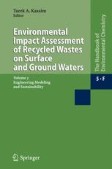Search
Search Results
-
Study on thermal conductivity of non-aqueous phase liquids-contaminated soils
PurposeThis paper studies the effects of non-aqueous phase liquids (NAPLs) content and soil structural anisotropy on the thermal conductivity of...

-
Vertical Light Non-Aqueous Phase Liquid (LNAPL) distribution by Rn prospecting in monitoring wells
In the frame of a collaboration between the Italian National Research Council (CNR) and Mares s.r.l., a study, about the possibility of determining...

-
Dense non-aqueous phase liquid chlorinated contaminant detected far from the source release area in an aquifer
Here we confirm migration of chlorinated solvents tetrachloroethene and trichloroethene, and co-disposed elemental mercury as dense non-aqueous phase...

-
A Review on In Situ Remediation of NAPLs Contaminated Soil: Methods and Development Prospects
Soil organic pollution is a prevalent problem all over the world, and it is also the key and difficult point of soil pollution control....
-
Nonaqueous Phase Liquid Pool Dissolution in Subsurface Formations
The objective of this chapter is to present some recent developments on nonaqueous phase liquid (NAPL) pool dissolution in water saturated subsurface...
-
Free Product Recovery of Non-aqueous Phase Liquids in Contaminated Sites: Theory and Case Studies
Organic liquids with low water solubility are generally described as Non-Aqueous Phase Liquids (NAPLs). They penetrate the soil subsurface as oily...
-
Effect of Residual NAPLs on the Transport of Bisphenol A and Bisphenol S in Saturated Porous Media
Endocrine disrupter, like bisphenol A (BPA) and bisphenol S (BPS), is frequently detected in the subsurface environment, imposing threats to the...

-
Delineation of LNAPL plumes in a clay-rich site in Gyeongsangnam-do Province, South Korea: integration of geophysical survey data with borehole data and soil sampling information
To effectively delineate the spatial distribution of oil contaminant plumes, geophysical methods indirectly measure the physical properties of the...

-
Study of creosote transport properties in sandy and clay soils
Creosote is an organic pollutant formed by a complex mixture of highly toxic and carcinogenic compounds and classified as a dense non-aqueous phase...

-
Recent advancement in enhanced soil flushing for remediation of petroleum hydrocarbon-contaminated soil: a state-of-the-art review
Remediation of persistent organic pollutants in soil especially total petroleum hydrocarbon (TPH) is of global concern due to its toxicity and health...

-
Equilibrium Partitioning and Mass Transfer of Organic Chemicals Leached from Recycled Hazardous Waste Materials
Potentially hazardous waste materials (HWMs) are increasingly being recycled and used as highway construction and repair materials (CRMs). While...
-
The Performance of Slurry Phase Reactors on the Treatment of Polycyclic Aromatic Hydrocarbons from Soils
The contaminated Kaynaklar soil containing high level of diesel (100,000 mg/kg dw) was treated in slurry systems with solid-to-liquid ratios (S/L) of...

-
Investigation of relative permeability, saturation and capillary pressure relations of NAPL-contaminated sands
PurposeThe relations among relative permeability, saturation degree and capillary pressure ( k r – S – P ) in a three-phase system are important...

-
Interaction quantitative modeling of mixed surfactants for synergistic solubilization by resonance light scattering
In situ flushing through surfactant-enhanced aquifer remediation (SEAR) technology has long been recognized as a promising technique for NAPL removal...

-
Organic Contaminants in Urban Soils
Organic pollutants are predominantly synthetic compounds made or extracted by humans, and it is therefore not surprising that they are common...
-
Remediation of Diesel-Contaminated Aquifers Using Thermal Conductive Heating Coupled With Thermally Activated Persulfate
Diesel fuel contamination of aquifers is a global environmental problem. In recent years, in situ thermal remediation (ISTR) has attracted much...

-
Nutrient Loading Impact on Remediation of Hydrocarbon Polluted Groundwater Using Constructed Wetland
Pollution of soil–water resources by the release of hydrocarbons is a major concern because of the wide coverage of groundwater table by these...
-
Application of nanotechnology in removal of NAPLs from contaminated aquifers: a source clean-up experimental study
This work investigates the removal of non-aqueous phase liquids (NAPLs) from groundwater resources using nanotechnology. We present results of a...

-
Mobilization of Per- and Polyfluoroalkyl Substances (PFAS) in Soils: A Review
Purpose of ReviewSoils can receive a considerable amount of perfluoroalkyl and polyfluoroalkyl substances (PFAS) via different contamination...

-
Solid and Semi-Solid Waste Management
Generation of solid and semi-solid waste is part of any civilization. The positive or negative impacts of solid waste management on health, as well...
